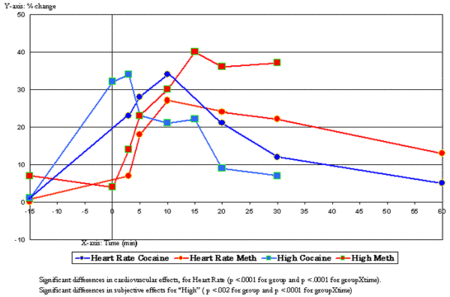Conventional wisdom asserts that drugs of abuse have
different patterns of action and that a drug of choice among abusers is the
drug that best fits abusers’ preferred course of action (Khantzian &
Shaffer, 1981; Mathias, 2001; Shaffer & Simoneau, 2001). However, empirical evidence about the matter
also indicates that an abuser’s drug of use also depends on its ease of access,
ingestion, and surrounding social circumstances (Harford, 1978). In this issue of STASH, we
discuss Newton, De La Garza II, Kalechstein, and Nestor’s (2005) comparison of the subjective
and physiologic effects of cocaine and methamphetamine.
In this single-blind experiment, researchers administered
saline placebo and 40mg of cocaine to 14 non-treatment seeking cocaine
dependent volunteers and saline placebo and 30mg of methamphetamine to 11
non-treatment seeking methamphetamine dependent volunteers. Researchers had
detoxed patients for 3 days prior to the study. They measured how “high” the
subjects were by obtaining their subjective ratings of adjectives. The researchers
recorded cardiovascular responses by automatically monitoring heart rate, and
systolic and diastolic blood pressure (BP). Both the physiological and
subjective measures were obtained at -15, 3, 6, 10, 15, 20, and 30 minutes
after injection of saline placebo followed by the active drug of choice. Heart
rate also was measured at 60 minutes post injection. Researchers used repeated
measures analyses of variance (ANOVA) and Huynh-Feldt sphericity correction to
calculate time and group by time effects from the observed data.
Figure 1 shows that the participants’ description of “highs”
correlated with heart rates; this was evidenced for both cocaine (red lines)
and methamphetamine (blue lines). Methamphetamine produced a later onset and longer surge (square markers)
than cocaine (diamond markers). Methamphetamine’s
cardiovascular effects were felt at five minutes, peaked at 10 minutes, and
remained relatively high for an extended period of time. Cocaine, on the other
hand, caused an immediate reaction that peaked after10 minutes for heart rate.
However, after the peak, the effects of cocaine diminished rapidly and the
users returned to almost their initial, baseline state.
Figure. Cardiovascular and Subjective Effects: Methamphetamine vs. Cocaine (Adapted from: Newton et al, (2005) Click image to enlarge.
This study has some limitations. First, the cocaine and
methamphetamine groups might not be representative of the cocaine and methamphetamine
dependent populations. (Substance Abuse and
Mental Health Services Administration, 2007a, 2007b; Winslow, 2007).
Second, researchers administered both drugs intravenously, which can result in
a different rate of absorption than other routes of administration for these
users. Users often have several routes of administration (e.g., oral, inhaled,
intravenous). Third, laboratory settings are very different from the in vivo
contexts within which users administrate their drugs. Research has shown that the
social setting influences subjective state more than most observers recognize (Zinberg, 1984).
Despite these limitations, the mean heart rate changes
and the participants’ descriptions of subjective effects indicate a correlation
between substance user perceptions, drug induced physiological effects, and the
need that these circumstances create for drug use. An understanding of the
preferred type or attributes of drug effect could help researchers and
practitioners to better redirect craving and find healthier substitutes. For
example, a methamphetamine user could redirect addictive tendencies towards
another stimulating activity (e.g., cross country running), which somewhat
mimics, but is healthier, than stimulant use.
What do you think? Please use the comment link below to provide feedback on this article.
References
Harford, R. J. (1978). Drug Preferences of multiple drug
abusers. Journal of Consulting and Clinical Psychology, 46(5), 908-912.
Khantzian, E. J. (1975). Self selection and progression in
drug dependence. Psychiatry Digest, 36, 19-22.
Khantzian, E. J. (1997). The self-medication hypothesis of
substance use disorders: A reconsideration and recent applications. Harvard
Review of Psychiatry, 4(5), 231-244.
Mathias, R. (2001). Even Modest Cocaine Use May Cause Brain
Changes That Could Contribute to Addiction. NIDA Notes, 16(3).
Newton, T. F.,
De La Garza II, R., Kalechstein, A.D. , Nestor, L. (2005). Cocaine and methamphetamine
produce different patterns of subjective and cardiovascular effects.
Pharmacology, Biochemistry and Behavior, 82(1), 90-97.
Simon, S. L., Richardson, K., Dacey, J, Glynn, S, Domier,
C.P., Rawson, R.A., et al. (2002). A comparison of patterns of methamphetamine
and cocaine use. Journal Addictive Disorders, 21(1), 35-44.
Substance Abuse and Mental Health Services Administration.
(2007a). The NSDUH Report: Demographic and Geographic Variations in Injection
Drug Use.Rockville.
Substance Abuse and Mental Health Services Administration.
(2007b). The NSDUH Report: Worker Substance Use, by Industry Category.Rockville.
Winslow, B. T., Voorhees, K.I, Pehl K.A. (2007). Methamphetamine
Abuse. American Family Physician, 76(8), 1169-1174.
Zinberg, N. E. (1984). Drug, Set, and Setting: The Basis for
Controlled Intoxicant Use. New Haven: Yale University
Press.





